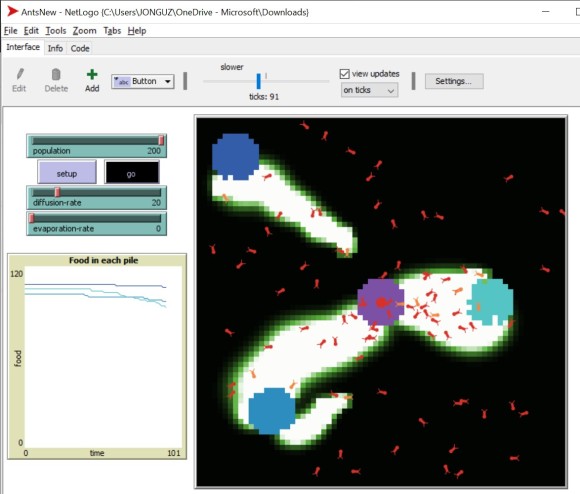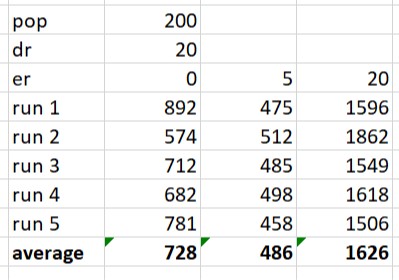Today I started my Complexity Explorer course from the Santafe Institute. It’s completly free and It got me fully engaged. In the first module they introduced the NetLogo simulator.
The first lab is about an ant colony simulation and how they can gather food using feromones as a way to coordinate globally using just local signals. It’s fascinating how in complex systems this simple local behavior results in such sophisticated global coordination.

We have 3 parameters; population, diffusion-rate and evaporation-rate. The task is to test how efficient the colony is on gathering all the available food found in three sources nearby the hive. This efficiency is measured throught the time it take to them to gather all food.
We start with a fixed population of 200 and a diffusion-rate of 20. The first one is just how many ants will be in the simulation randomly searching for food. The second one is less obvious but it have to do with how strong is the trace that ants left behind to signal others ants that they have found food while they return to hive.
Then we have a parameter that we can adjust to 0, 5 and 20 and run several times to see how it affects the final time. The evaporation-rate which seems to be the time that the signal keeps in the “air” to other ants to find, the higher the more time it takes to disapper.
My intial intution is that the longer the evaporation-rate the faster the colony will collect all food because the chances that a nearby ant found the signal to trace back the food will be high as well.
This is the data of the first experiment:

Obviously I was wrong. I probably interpreted wrong the meaning of the evaporation-rate parameter or there is actually a non-linear relationship between this var and the total collection time.
After see the animation, it’s clear that I got the meaning in the otherway around. But still I wonder why when evaporation-rate is set in 0 it tooks more time than when it is set in 5.
This is just section 1.7, let see how it turns.
- Wilensky, U. (1997). NetLogo Ants model. http://ccl.northwestern.edu/netlogo/models/Ants. Center for Connected Learning and Computer-Based Modeling, Northwestern University, Evanston, IL.
- Wilensky, U. (1999). NetLogo. http://ccl.northwestern.edu/netlogo/. Center for Connected Learning and Computer-Based Modeling, Northwestern University, Evanston, IL.